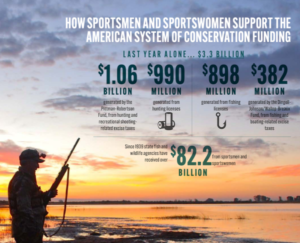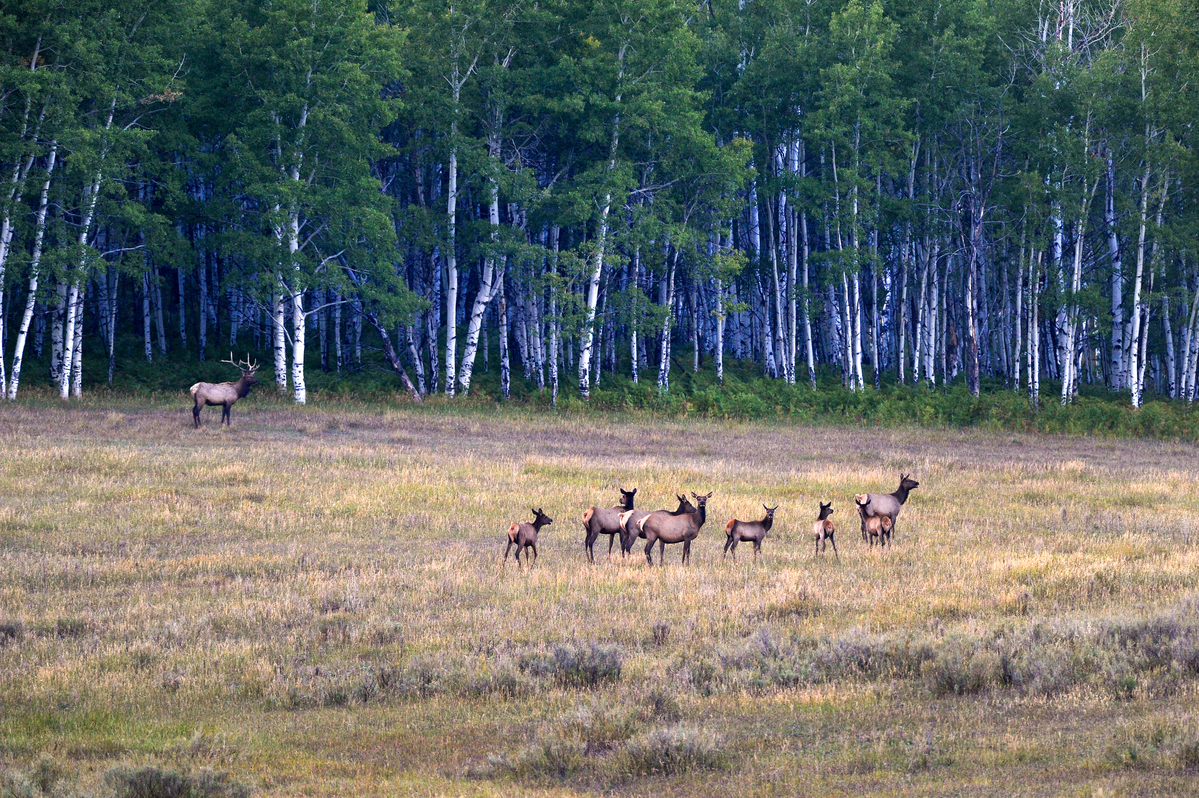Below is an article featured in the September 26, 2024, issue of Outdoor Wire. The Rocky Mountain Elk Foundation is a member of the American Wildlife Conservation Partners and hosted the group’s national gathering earlier this summer.
The first thing you need to know about America’s sportsmen and sportswomen is that they fund conservation and wildlife management in our country. If you enjoy the outdoors and the wildlife that found there, you need to be thanking those Americans that embrace the sporting lifestyle.
I’m talking the hunters, anglers, trappers and shooters – what the Outdoor Stewards of Conservation Foundation has termed H.A.T.S. – through whose investment in their outdoors activities we’ve been benefiting.
How much of an investment you ask? A lot.
Last year that figure was $3.3 Billion, with a ‘B’ as people like to say. As you can see in the graphic above, that money came from Pittman-Robertson Fund and the excise taxes from the sale of handguns (10%), rifles and shotguns (11%), ammo (11%), firearm parts and accessories (11%) and archery equipment (11%), which accounted for $1.06 billion.
Another $990 million was raised through the sale of hunting licenses, while fishing license sales accounted for an additional $898 million. Finally, $382 million came from the Dingell-Johnson/Wallop-Breaux Fund which generates funding from fishing and boating-related excise taxes.

That $3.3 billion is indeed a lot but not compared to the overall $82.2 billion that has gone to state fish and wildlife agencies since 1939. Sportsmen and Sportswomen account for 60% of the funding of these state agencies.
So, with all that funding how do we maximize the impact of those dollars to greatest benefit to conservation and wildlife management, while also benefiting those that spent that $3.3 billion to begin with?
You need a game plan. A blueprint if you will. And that’s exactly what we got two weeks ago when the American Wildlife Conservation Partners (AWCP) released their report, Wildlife for the 21st Century Volume VII.
The AWCP is comprised of the nation’s top 52 sporting-conservation organizations representing hunter-conservationists, professional wildlife and natural resource managers, outdoor recreation users, conservation educators, and wildlife scientists. In their report these organizations came together to outline nine recommendations aimed at guiding the next presidential administration, and the next two Congresses, to ensure the wise use of our public resources.
With the ongoing effort to replace wildlife management with ballot box biology, taking the control of wildlife management away from wildlife professionals and scientists and putting it to the hands of voters, who aren’t using a state’s natural resources and certainly not paying for them, a blueprint like this one is critical to spending that annual $3 billion-plus funding the right way.
The first three recommendations caught my attention. What speaks to you might be completely different.
The first recommendation is to protect and secure permanent and dedicated conservation funding, noting that “Meaningful conservation efforts require sustained and predictable funding to be effective. Funding is central to Wildlife for the 21st Century and that is why funding is at the top of AWCP’s priorities.”
There are 14 sub-recommendations that include maintaining the integrity of the Pittman-Robertson Act; making the Wildfire Suppression Operations Reserve Fund permanent; fully fund the activities authorized under the CWD Research and Management Act and complete the comprehensive CWD Study convened by the National Academy of Sciences; among others.
In a current budget climate where $1.2 Trillion – with a ’T’ – is going towards interest payments in 2024, the highest amount ever recorded, funding is always in jeopardy. Working with the Administration and Congress to protect critical investment is the top priority.
The second recommendation is to enhance access for hunters, shooters, and other outdoor recreationists. Access is a never-ending battle as development and urban sprawl overtake open lands.
Under the subheading of Protect and Increase Access of Opportunity, three sub-recommendations stood out for me. They are to pass legislation that directs BLM and USFS to develop shooting ranges in each public land unit; mitigate recreational shooting closures on federal land through creation of new public shooting ranges; and maintain public access for hunting and shooting if and when redesignation of federal land occurs.
These hit home with those of us that live in the Western U.S. where we have access to public lands. BLM land is a very popular place to go shooting here in Arizona. We also have a nearby public range on BLM land that has drawn a lot of recreational shooters with its three bays and permanent steel targets.
Access for shooters is critical because, as the report notes, “Target shooting is an Olympic sport and crucial source of conservation funding through ammunition excise tax revenues.”
The Wildlife Management Institute reports that 30% of the excise taxes fueling the Pittman-Robertson Fund comes from ammunition. Another 34% comes from the sale of pistols and revolvers.
The number of recreational shooters isn’t an easy number to come by since unlike with hunters no ‘shooting license’ is required. However, the number of shooters dwarfs the number of hunters by two to one, at least. In other words, shooters account for a significant portion of the $1.06 billion in P-R funds.
The third recommendation that jumped out at me was one that addressed the very issue we’ve seen in news from state wildlife agencies here in the Western U.S., and that’s to institutionalize and support wildlife migration corridors and seasonal habitats.
Wildlife migration corridors might not mean a lot to those living on the coasts where federal lands don’t make up a major portion of the state, but here in the west with its large migrating wildlife herds, the simple issue of providing for safe passage for elk, mule deer and other wildlife over interstate highways is a meaningful investment in wildlife conservation.
As the report notes, “Technology has allowed researchers to document the location of migration routes, stop-overs, and bottlenecks along migration corridors with precision. This enables managers to focus conservation efforts on these vital habitats.”
And through a pilot program, properly constructed infrastructure, such as highway overpasses and underpasses designed for wildlife crossings, have reduced wildlife traffic mortality by as much as 80%. That’s why the report calls for reauthorize and to make permanent the existing Highway Crossing Pilot Program established in the Infrastructure Investment and Jobs Act.
Essentially, what the report is saying is that before we over-develop rural areas, like those in the west, we use the technology and the science to preserve habitat bridges to facilitate animal migration. Because once those areas are developed without wildlife in mind, it’s too late.
These are just three of the nine recommendations that jumped out at me. Going through the report on your own will bring forward priorities that resonate with you and where you live in the country.
The most important aspect of the report is that, while it is designed to guide the budgeting and law-making process in Washington D.C., it gives you, me and other sportsmen and sportswomen the info we need to talk to our own Congressperson or Senator to let them know we are counting on them to spend the funds we as taxpayers provided – and spend it correctly.
Using our individual voices in unison with that of our friends in the conservation and sporting organizations, as well as the wildlife and conservation professionals within the state fish and wildlife agencies, we can help make the future outlined in the Wildlife for the 21st Century Volume VII a reality. At least as much as possible over the next four years.
— Paul Erhardt, Managing Editor, the Outdoor Wire Digital Network
(Graphic credit: Outdoor Wire)
(Photo credit: Rocky Mountain Elk Foundation)
